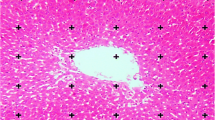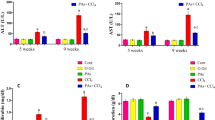Abstract
Our aim was to study the protective effect of quercitin on liver cirrhosis induced by carbon tetrachloride (CCl4) in rats and its relationship with liver morphology. Thirty male Wistar rats weighing 200–250 g were randomly divided into three groups: control, CCl4, and CCl4+ quercetin. Rats in the experimental groups were given CCl4 (0.5 ml/kg i.p.), diluted 1:6 in vegetable oil (5 mmol/kg body wt), at 10:00 p.m. every 4 days for 17 weeks. Quercetin (500 μl/kg i.p.; 150 μmol/kg body wt) or vehicle was administered at 6:00 p.m. for the last 3 weeks of the study. Control group rats were given only olive oil for the same period. At the end of the 17 weeks, all rats were sacrificed. Blood samples were taken for determination of serum indicators (ALT, AST, total bilirubin, conjugated bilirubin, factor V) and the livers were dissected out and divided into two parts: one was homogenized and the supernatant was used for measurement of superoxide dismutase (SOD), catalase, and glutathione peroxidase (GPx) activities, as well as lipid peroxidation. The other part was used for the histopathological study. CCl4 caused a marked rise in serum levels of ALT, AST, total bilirubin, and conjugated bilirubin, as well as a decrease in factor V (P<0.05). Lipid peroxidation levels were significantly increased, whereas GSH, SOD, catalase, GPx, and GST levels were decreased in the liver of CCl4-treated rats. Quercetin (50 mg/kg/day) successfully attenuated these effects of CCl4. We conclude that quercetin has beneficial effects on liver fibrosis in rats by enhancing antioxidant enzyme activity and decreasing the pro-oxidant effect.
Similar content being viewed by others
References
Recknagel RO, Glende EA, Hruszkewycz AM (1977) Chemical mechanisms in carbon tetrachloride toxicity. In: Free radicals in biology. Pryor WA (ed). Academic Press, New York, pp 97–132
Butler TC (1961) Reduction of carbon tetrachloride in vivo and reduction of carbon tetrachloride and chloroform in vitro by tissues and tissue constituents. J Pharmacol Exp Ther 134:311–319
Fowler JSL (1969) Carbon tetrachloride metabolism in the rabbit. Br J Pharmacol 37:733–737
Poyer JL, McCay PB, Lai EK, Jenzen EG, Davis ER (1980) Confirmation of assignment of the trichloromethyl radical spin adduct detected by spin trapping during 13C-carbon tetrachloride metabolism in vitro and in vivo. Biochem Biophys Res Commun 94:1154–1160
Packer JE, Slater TF, Willson RL (1978) Reactions of the carbon tetrachloride-related peroxy free radical with amino acids: pulse radiolysis evidence. Life Sci 23:2617–2620
Bonis P, Friedman SL, Kaplan MM (2001) Is liver fibrosis reversible. N Engl J Med 344(6):452–454
Perez-Tamayo R (1983) Is cirrhosis of the liver experimentally produced by CCl4 an adequate model of human cirrhosis? Hepatology 3:112–120
Formica JV, Regelson W (1995) Review of the biology of quercetin and related bioflavonoids. Food Chem Toxicol 33:1061–1080
Iwao K, Tsukamoto I (1999) Quercetin inhibited DNA synthesis and induced apoptosis associated with increase in c-fos mRNA level and the upreglutation of p21WAF1C1P1 mRNA and protein expression during liver regeneration after partial hepatectomy. Biochim Biophys Acta 1427:112–120
Sanders RA, Rauscher FM, Watkins JB (2001) Effects of quercetin on antioxidant defense in streptozotocin-induced diabetic rats. J Biochem Mol Toxicol 15:143–149
Pavanato A, Tuñón MJ, Sánchez-Campos S, Marroni CA, Llesuy S, González-Gallego J, Marroni N (2003) Effects of quercetin on liver damage in rats with carbon tetrachloride-induced cirrhosis. Dig Dis Sci 4:824–829
Poli G, Parola M (1997) Oxidative damage and fibrogenesis. Free Rad Biol Med 22:287–305
Manach C, Texier O, Morand C, Crespy V, Regerat V, Demigne C, Remesy C (1999) Comparison of the bioavailability of quercetin and catechin in rats. Free Radic Biol Med 27:1259–1266
Park C, So H, Shin C, Baek S, Moon B, Shin S, Lee HS, Lee DW, Park R (2003) Quercetin protects the hydrogen peroxide-induced apoptosis via inhibition of mitochondrial dysfuntion in H9c2 cardiomyoblast cells. Biochem Pharmacol 66(7):1287–1295
National Academy of Sciences (1991) The guiding principles for research involving animals. National Institutes of Health, Bethesada, MD
Llesuy SF, Milei J, Molina H, Boveris A, Milei S (1985) Comparison of lipid peroxidation and myocardial damage induced by adriamycin and 4’-epiadriamycin in mice. Tumori 71:241–249
Fridovich I (1974) Superoxide and evolution. Horizons Biochem Biophys 1:1–18
Flohé L, Gunzler WA (1984) Assay of glutathione peroxidase. Methods Enzymol 105:114–121
Beers RF Jr, Sizer IW (1952) A spectrophotometric method for measuring the breakdown of hydrogen peroxide by catalase. J Biol Chem 195:133–140
Chance B, Sies H, Boveris A (1979) Hydroperoxide metabolism in mammalian organs. Physiol Rev 59:527–625
Habig WH, Pabst MJ, Jakoby WB (1974) The first enzymatic step in mercapturic acid formation. J Biol Chem 249:7130–7139
Buege JÁ, Aust SD (1978) Microsomal lipid peroxidation. Methods Enzymol 52:302–309
Lowry OH, Rosebrough AL, Farr AL, Randall R (1951) Protein measurement with the Folin phenol reagent. J Biol Chem 193:265–275
Aleynik SI, Leo MA, Ma X, Aleynik MK, Lieber CS (1997) Polyenylphosphatidylcholine prevents carbon tetrachloride-induce lipid peroxidation while it attenuates. J Hepatol 27(3):554–561
Brattin WJ, Glende EA Jr, Recknagel RO (1985) Pathological mechanisms in carbon tetrachloride hepatotoxicity. J Free Radic Biol Med 1(1):27–38
Glende EA Jr, Recknagel RO (1991) An indirect method demonstrating that CCl4-dependent hepatocyte injury is linked to a rise in intracellular calcium ion concentration. Res Commun Chem Pathol Pharmacol 73(1):41–52
Williams AT, Burk RF (1990) Carbon tetrachloride hepatotoxicity: an example of free radical-mediated injury. Semin Liver Dis 10(4):279–284
Jeon TI, Hwang SG, Park NG, Jung YR, Shin SI, Choi SD, Park DK (2003) Antioxidative effect of chitosan on chronic carbon tetrachloride induced hepatic injury in rats. Toxicology 187:67–73
Fort J, Oberti F, Pilette C, Veal N, Gallois Y, Douay O, Rousselet MC, Rosenbaum CP (1998) Antifibrotic and hemodynamic effects of the early and chronic administration of octreotide models of liver fibrosis in rats. Hepatology 28(6):1525–1531
Castilla-Cortazar I, Garcia M, Muguereza B, Quiroga J, Perez R, Santidrian S, Prieto J (1997) Hepatoprotective effects of insulin-like growth factor I in rats with carbon tetrachloride-induced cirrhosis. Gastroenterology 13:1682–1691
Muriel P (1998) Nitric oxide protection of rat liver from lipid peroxidation, collagen accumulation, and liver damage induced by carbon tetrachloride. Biochem Pharmacol 56:773–779
Hernández-Muñhoz R, Diaz-Muñhoz M, Suárez-Cuena JÁ, Trejo-Solís C, López V, Sánchez-Sevilla Y, De Sánchez VC (2001) Adenosine reverses a preestablished CCl4-induced micronudular cirrhosis trhough enhancing collagenolytic activity and stimulating hepatocyte cell proliferation in rats. Hepatology 34(4):677–687
García L, Hernádez I, Sandoval A, Salazar A, Garcia J, Vera J, Grijalva G, Muriel P, Margolin S, Armendariz-Borunda J (2002) Pirfenidone effectively reverses experimental liver fibrosis. J Hepatol 37:797–805
Peres W, Tuñón MJ, Collado PS, Matos SH, Marroni N, Gonzalez-Gallego J (2000) The flavonoid quercetin ameliorates liver damage in rats with biliary obstruction. J Hepatol 33:742–750
Brandão ABL, Marroni CA (2001) Testes de função hepática. In: Compêndio de Hepatologia., Mattos AA, Dantas W (eds). Fundação BYK, São Paulo
Yokogawa K, Watanabe M, Takeshita H, Nomura M, Mano Y, Myamoto KI (2004) Serum aminotransferase activity as a predictor of clearance of drugs metabolized by CYP isoforms in rats with acute hepatic failure induced by carbon tetrachloride. Int J Pharm 269:479–489
Pastor A, Sánchez Collado P, Almar M, Barrientos C, González-Gallego J (1997) Antioxidant enzyme status in biliary obstructed rats: effects of S-adenosylmethionine. J Hepatol 27:363–367
Halliwell B, Gutteridge JMC (1999) Free radicals in biology and medicine. Oxford University Press, New York
Tappel AC (1973) Lipid peroxidation damage to cell components. Fed Proc 32:1870–1874
Lin CC, Yen MH, Lo TS, Lin JM (1998) Evaluation of the hepatoprotective and antioxidant activity of Boehmeria nivea var. nivea and B. nivea var. tenacissima. J Ethnopharmacol 60:9–17
Kadiiska MB, Gladen BC, Baird DD, Dikalova AE, Sohal R S, Hatch GE, Jones DP, Mason RP, Barrett JC (2000) Biomarkes of oxidative stress study: are plasma antioxidants markers of CCl4 poisoning? Free Rad Biol Med 28(6):838–845
Corrales F, Giménez A, Alvarez L, Caballería J, Pajares M A, Andreu H, Parés A, Mato JM, Rodés J (1992) S-Adenosylmethionine treatment prevents carbon tetrachloride-induced S-adenosylmethionine synthetase inactivationand attenuates liver injury. Hepatology 16:1022–1027
Gassó M, Rubio M, Varela G, Cabré M, Caballería J, Alonso E, Deulofem R, Camps, J, Giménez A, Pajares M, Parés A, Mato JM, Rodés J (1996) Effects of S-adenosylmethionine on lipid peroxidation and liver fibrogenesis in carbon tetrachloride-induced cirrhosis. J Hepatol 25:200–205
Hernández-Muñhoz R, Díaz-Muñhoz M, López V, López-Barrera F, Yánez L, Vidrio S, Aranda-Fraustro A, Sánchez VC (1997) Balance between oxidative damage and proliferative potential in an experimental rat model of CCl4-induced cirrhosis: protective role of adenosine administration. Hepatology 26:1100–1110
Cabre M, Camps J, Paternain JL, Ferre N, Joven J (2000) Time-course of changes in hepatic lipid peroxidation and glutathione metabolism in rats with carbon tetrachloride-induced cirrhosis. Clin Exp Pharmacol Physiol 27(9):694–699
Lee MH, Yoon S, Moon JO (2004) The flavonoid naringenin inhibits dimethylnitrosamine-induced liver damage in rats. Biol Pharm Bull 27(1):72–76
Hsiao G, Lin YH, Lin CH, Chou DS, Lin WC, Sheu JR (2001) The protective effects of pmc against chronic carbon tetrachloride induced hepatotoxicity in vivo. Biol Pharm Bull 24(11):1271–1276
Murthy KNC, Jayaprakasha GK, Singh RP (2002) Studies on antioxidant activity of pomegranate (Punica granatum) peel extract using in vivo models. J Agr Food Chem 50:4791–4795
Lee TY, Mai LM, Wang GJ, Chiu JH, Lin YL, Lin HC (2003) Protective mechanism of salvia miltiorrhiza on carbon tetrachloride-induced acute hepatotoxicity in rats. J Pharmacol Sci 91:202–210
Flohé L, Gunzler Wa, Schock HH (1973) Glutathione peroxidase: a seleno-enzyme. Febs Lett 32:132–134
Jakoby WB (1988) Detoxification, conjugation and hydrolysis in liver biology and pathology. Raven Press, New York
Gaudio E, Onori P, Franchitto A, Sferra R, Riggio O (1997) Liver metabolic zonation and hepatic microcirculation in carbon tetrachloride-induced experimental cirrhosis. Dig Dis Sci 42(1):167–177
Schuppan D, Bauer M, Krebs A, Hahn EG (2001) Antifibrogenic treatment- present status and future directions. In: Therapy in hepatology. Arroyo V, Bosch J, Bruix J, Ginés P, Navasa M, Rodés J (eds). Ars Medica, Barcelona, pp 395–405
Author information
Authors and Affiliations
Corresponding author
Rights and permissions
About this article
Cite this article
Amália, P.M., Possa, M.N., Augusto, M.C. et al. Quercetin Prevents Oxidative Stress in Cirrhotic Rats. Dig Dis Sci 52, 2616–2621 (2007). https://doi.org/10.1007/s10620-007-9748-x
Received:
Accepted:
Published:
Issue Date:
DOI: https://doi.org/10.1007/s10620-007-9748-x




